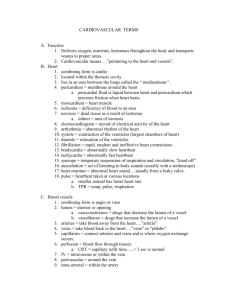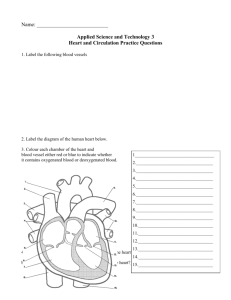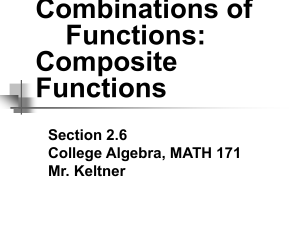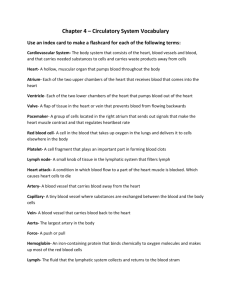Medical_Terminology07_Cardiovascular
advertisement
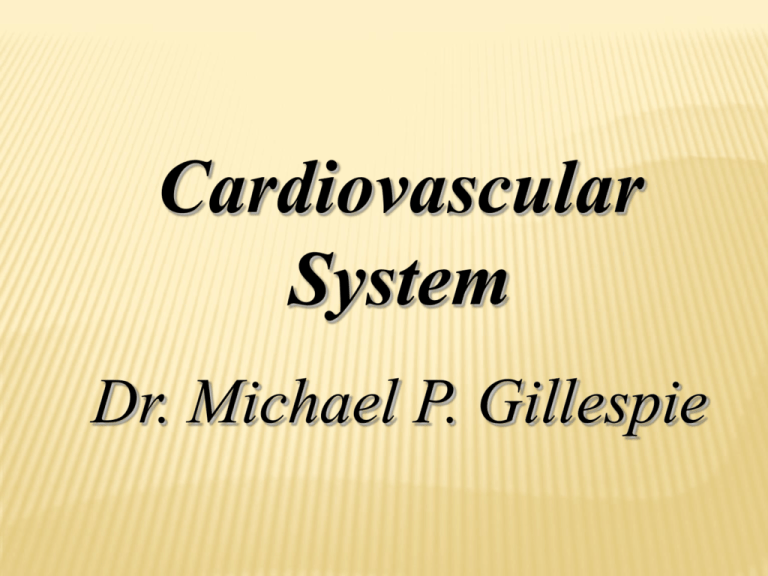
Cardiovascular System Dr. Michael P. Gillespie CHAPTER GOALS Name the parts of the heart and associated blood vessels and their functions in the circulation of blood. Trace the pathway of blood through the heart. Identify and describe major pathologic conditions affecting the heart and blood vessels. 2 CHAPTER GOALS (CONT’D) Define combining forms that relate to the cardiovascular system. Describe important laboratory tests and clinical procedures pertaining to the cardiovascular system, and recognize relevant abbreviations. Apply your new knowledge to understand medical terms in their proper context, such as in medical reports and records. 3 INTRODUCTION Cardiovascular System: delivers oxygen and nutrients to cells of body tissue Heart (muscular pump) Blood vessels (fuel line and transportation network) 4 BLOOD VESSELS AND THE CIRCULATION OF BLOOD Arteries are the vessels that lead away from the heart. Veins are thinner walled vessels compared to arteries. They move deoxygenated blood toward the heart from the tissues. Capillaries are the smallest vessels. They form the point of exchange for oxygen and nutrients into body cells and waste products coming from body cells. 5 BLOOD VESSELS 6 BLOOD CIRCULATION / SYSTEMIC CIRCULATION 7 MAJOR VESSELS 8 ANATOMY OF THE HEART 9 ANATOMY OF THE HEART 10 MAJOR VALVES OF THE HEART tricuspid valve (cusps are flaps of the valves): between right atrium and right ventricle pulmonary valve: between right ventricle and pulmonary artery Bicuspid (mitral valve): between left atrium and the left ventricle aortic valve: between left atrium and aorta 11 PATHWAY OF BLOOD THROUGH THE HEART 12 HEARTBEAT AND HEART SOUNDS Two phases of the heartbeat: diastole: relaxation systole: contraction The diastole-systole cardiac cycle occurs between 70 to 80 times per minute (100,000 times per day). The heart pumps 3 ounces of blood with each contraction. This means that about 5 quarts are pumped per minute (75 gallons an hour and about 2000 gallons a day). 13 HEART SOUNDS Closure of valves associated with sounds “lubbdubb, lubb-dubb” lubb: closure of the tricuspid and mitral valves at the beginning of systole dubb: closure of the aortic and pulmonary valves at the end of systole murmur: abnormal heart sound caused by improper valve closure 14 PHASES OF THE HEARTBEAT 15 PHASES OF THE HEARTBEAT 16 CONDUCTION SYSTEM OF THE HEART sinoatrial node (SA node): pacemaker of the heart pacemaker: origin of electrical impulse causing walls of the atria to contract and force blood into the ventricles (ending diastole) 17 CONDUCTION SYSTEM OF THE HEART Atrioventricular node (AV node): This sends the excitation wave to a bundle of specialized fibers called atrioventricular bundle or Bundle of His. Bundle of His (pronounced “hiss”): Helps form conduction myofibers that extend to ventricle walls and stimulate them to contract, beginning systole. A short rest period follows. The pacemaker begins wave of excitation again. ECG or EKG (electrocardiogram): The record used to detect electrical changes in heart muscle as the heart beats. 18 CONDUCTION SYSTEM OF THE HEART 19 CONDUCTION SYSTEM OF THE HEART 20 ELECTROCARDIOGRAM P wave = spread of excitation wave over the atria just before contraction; QRS wave = spread of excitation wave over the ventricles as the ventricles contract; T wave = electrical recovery and relaxation of ventricles. A heart attack (myocardial infarction or MI) can be recognized by an elevation in the S-T segment of the ECG. Thus, one type of MI is an S-T elevation MI or STEMI. 21 ELECTROCARDIOGRAM 22 ELECTROCARDIOGRAM 23 BLOOD PRESSURE Blood pressure: The force that blood exerts on arterial walls. Measured using sphygmomanometer Expressed as a fraction: systolic pressure/ diastolic pressure example: 120/80 mm Hg 24 COMBINING FORMS AND TERMINOLOGY Combining Form angi/o aort/o arter/o arteri/o ather/o atri/o Meaning vessel aorta artery artery yellowish plaque atrium 25 COMBINING FORMS AND TERMINOLOGY Combining Form brachi/o cardi/o cholesterol/o coron/o cyan/o myx/o Meaning arm heart cholesterol heart blue mucus 26 COMBINING FORMS AND TERMINOLOGY Combining Form ox/o pericardi/o phleb/o sphygm/o steth/o thromb/o Meaning oxygen pericardium vein pulse chest clot 27 COMBINING FORMS AND TERMINOLOGY Combining Form valvul/o valv/o vas/o vascul/o ven/o, ven/i ventricul/o Meaning valve valve vessel vessel vein ventricle 28 QUICK QUIZ: 1. The double-layered membrane surrounding the heart is the ___________. A. pericardium B. arteriole C. endocardium D. endothelium 29 QUICK QUIZ: 2. The contraction phase of the heartbeat is called _________. A. diastole B. vena cava C. systole D. septum 30 PATHOLOGY: THE HEART AND BLOOD VESSELS HEART arrhythmias heart block (atrioventricular block) flutter fibrillation 31 PATHOLOGY: THE HEART AND BLOOD VESSELS HEART congenital heart disease coarctation of the aorta (CoA) patent ductus arteriosus (PDA) septal defects (ASD and VSD) tetralogy of Fallot 32 PATHOLOGY: THE HEART AND BLOOD VESSELS HEART congenital heart disease (CHF): The heart is unable to pump the required amount of blood. In U.S., primarily the result of high blood pressure and coronary artery disease (see next slide) Results in pulmonary edema Fatal if untreated 33 PATHOLOGY: THE HEART AND BLOOD VESSELS HEART coronary artery disease (CAD) Atherosclerosis thrombotic occlusion (occlusive/mural) ischemia necrosis infarction Acute Coronary Syndromes (ACS) unstable angina myocardial infarction (MI) 34 PATHOLOGY: THE HEART AND BLOOD VESSELS HEART Coronary artery disease Drug therapies for CAD nitrates (nitroglycerin) aspirin beta-blockers ACE inhibitors calcium channel blockers statins 35 PATHOLOGY: THE HEART AND BLOOD VESSELS HEART Coronary artery disease Surgical therapies for CAD coronary artery bypass grafting (CABG) percutaneous coronary intervention (PCI) 36 PATHOLOGY: THE HEART AND BLOOD VESSELS HEART Other Pathologic conditions endocarditis (vegetations) hypertensive heart disease mitral valve prolapse (MVP) murmur pericarditis rheumatic heart disease 37 PATHOLOGY: THE HEART AND BLOOD VESSELS BLOOD VESSELS aneurysm deep vein thrombosis (DVT) hypertension (HTN) peripheral vascular disease (PVD) Raynaud disease varicose veins 38 QUICK QUIZ: 3. Which arrhythmia refers to rapid, random, inefficient and irregular contractions of the atria and ventricles (350 beats or more per minute)? A. fibrillation B. flutter C. bradycardia 39 LABORATORY TESTS BNP test lipid test profile lipoprotein electrophoresis serum enzyme tests 40 CLINICAL PROCEDURES: DIAGNOSTIC X-Ray angiography and arteriography computerized tomography angiography digital subtraction angiography (DSA) Electron beam computed tomography (EBCT or EBT) Ultrasound Tests Doppler ultrasound echocardiography (ECHO) 41 CLINICAL PROCEDURES: DIAGNOSTIC Nuclear Cardiology positron emission tomography (PET) scan technetium (Tc) 99m Sestamibi scan (Cardiolite) Thallium-201 scan Magnetic Resonance Imaging (MRI) cardiac MRI 42 CLINICAL PROCEDURES: DIAGNOSTIC Other diagnostic procedures: cardiac catheterization electrocardiography (ECG, EKG) Holter monitoring stress test 43 CLINICAL PROCEDURES: DIAGNOSTIC Identify the normal sinus rhythm and arrhythmias 44 CLINICAL PROCEDURES: TREATMENT cardioversion (defibrillation) endarterectomy extracorporeal circulation heart transplantation thrombolytic therapy 45 CLINICAL PROCEDURES: TREATMENT Coronary artery bypass graft (CABG) surgery. A: Section of a vein is removed from the leg and anastomosed to a coronary artery to bypass an area of arteriosclerotic blockage. B: An internal mammary artery is grafted to a coronary artery to bypass blockage. 46 CLINICAL PROCEDURES: DIAGNOSTIC A Normal sinus rhythm. Notice the regularity of the P, QRS, and T waves. B Atrial flutter. Notice the rapid atrial rate (P wave) compared to the slower ventricular rate (ARS). C Atrial fibrillation. P waves are replaced by irregular and rapid fluctuations. There are no effective atrial contractions. D Ventricular tachycardia. Ventricular rate may be as high as 250 beats per minute. The rhythm is regular, but the atria are not contributing to ventricular filling and blood output is poor. 47 TREATMENT PROCEDURES percutaneous coronary intervention (PCI) includes: percutaneous transluminal coronary angioplasty (PTCA), stent placement, laser angioplasty, and atherectomy 48 ABBREVIATIONS Cath MR PCI PVC HTN ECG LDL BBB CAD CVP Vfib PDA BP SOB LMWH ICD LVAD ASD CABG ECHO MVP 49 QUICK QUIZ: 4. Which procedure involves insertion of a balloon-tipped catheter into a coronary artery? A. thrombolytic therapy B. coronary artery bypass grafting C. percutaneous coronary intervention D. endarterectomy 50 REVIEW SHEET COMBINING FORMS Combining Form angi/o aort/o arter/o arteri/o ather/o atri/o Meaning ______________ ______________ ______________ ______________ ______________ ______________ 51 REVIEW SHEET COMBINING FORMS Combining Form angi/o aort/o arter/o arteri/o ather/o atri/o Meaning vessel aorta artery artery yellowish plaque atrium 52 REVIEW SHEET COMBINING FORMS Combining Form Meaning brachi/o cardi/o cholesterol/o coron/o cyan/o myx/o ______________ ______________ ______________ ______________ ______________ ______________ 53 REVIEW SHEET COMBINING FORMS Combining Form Meaning brachi/o cardi/o cholesterol/o coron/o cyan/o myx/o arm heart cholesterol heart blue mucus 54 REVIEW SHEET COMBINING FORMS Combining Form ox/o pericardi/o phleb/o pulmon/o rrhythm/o sphygm/o steth/o thromb/o Meaning ______________ ______________ ______________ ______________ ______________ ______________ ______________ ______________ 55 REVIEW SHEET COMBINING FORMS Combining Form ox/o pericardi/o phleb/o pulmon/o rrhythm/o sphygm/o steth/o thromb/o Meaning oxygen pericardium vein long rhythmn pulse chest clot 56 REVIEW SHEET COMBINING FORMS Combining Form Meaning valvul/o valv/o vas/o vascul/o ven/o, ven/i ventricul/o ______________ ______________ ______________ ______________ ______________ ______________ 57 REVIEW SHEET COMBINING FORMS Combining Form Meaning valvul/o valv/o vas/o vascul/o ven/o, ven/i ventricul/o valve valve vessel vessel vein ventricle 58 REVIEW SHEET SUFFIXES Suffix -constriction -dilation -emia -graphy -lysis -megaly Meaning ______________ ______________ ______________ ______________ ______________ ______________ 59 REVIEW SHEET SUFFIXES Suffix -constriction -dilation -emia -graphy -lysis -megaly Meaning narrowing widening; stretching; expanding blood condition process of recording breakdown; separation; destruction; loosening enlargement 60 REVIEW SHEET SUFFIXES Suffix Meaning -meter ______________ -oma -osis -plasty -sclerosis -stonosis -tomy ______________ ______________ ______________ ______________ ______________ ______________ 61 REVIEW SHEET SUFFIXES Suffix Meaning -meter measure -oma -osis -plasty -sclerosis -stonosis -tomy tumor; mass; fluid collection condition; usually abnormal surgical repair hardening tightening; structure process of cutting 62 REVIEW SHEET PREFIXES Prefix Meaning a-, an ______________ brady- ______________ de- ______________ dys- ______________ endo- ______________ hyper- ______________ 63 REVIEW SHEET PREFIXES Prefix a-, an Meaning no; not; without brady- slow de- lack of; down; less; removal of dys- bad; painful; difficult; abnormal endo- in; within hyper- above; excessive 64 REVIEW SHEET PREFIXES Prefix Meaning hypo- ______________ inter- ______________ peri- ______________ tachy- ______________ tetra- ______________ tri- ______________ 65 REVIEW SHEET PREFIXES Prefix Meaning hypo- deficient; below; under; less than normal inter- between peri- surrounding tachy- fast tetra- four tri- three 66


